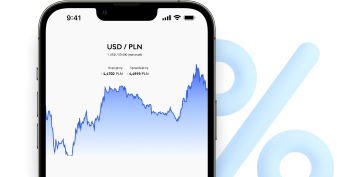Exchange rate MXN - Mexican peso
The Mexican peso is the official currency in Mexico. One Mexican peso consists of 100 cents.
Select currencies and check rates
Live rates.
Update: 30s
| Currency | Buy | Sell | Name | Currency code |
|---|---|---|---|---|
| MXN PLN | 0.1687 | 0.2105 | Mexican peso | 1 MXN |
Mexican peso exchange rate - chart
Last currency comments
Over 900 000 reviews
Customers rate us 4.9/5.0.*
Start saving today
Forget about unfavourable rates and hidden fees. See how much you can save. Create a free account and start converting currency online.
Open account for freeMexican peso
The Mexican peso is the official currency of Mexico. The international symbol for this currency is MXN. It is also written with the abbreviation $ or Mex$. The Mexican peso is divided into 100 centavos.
The Mexican peso - where is ist used?
The Mexican peso (MXN) is the official legal tender of only one country: Mexico. When travelling to this enchanting country, it is a good idea to check the peso exchange rate (e.g. by searching on the Internet for MXN exchange rate), keeping in mind that peso in the local language refers to the singular, while pesos refers to the plural. Therefore, we say 1 peso, but 2 pesos, 5 pesos, etc. The Mexican peso (MXN to EUR) is the most significant when it comes to travelling and leisure. Mexico is quite popular among tourists.
The history of the Mexican peso
The origins of the Mexican peso can be traced back to colonial times when the conquistadors arrived in modern Mexico. The Spaniards heavily exploited the raw materials discovered there and used them to mint coins, including silver ones worth 8 reals. These were the Spanish dollars, which found their way into wide circulation in America and Asia. Their popularity was so great that at one point, the United States adopted them as official currency. Some coins worth 8 reals were also called pesos. The Spanish dollar was used in Mexico until 1821, although in the meantime, there was money issued by the revolutionaries of the independent state. After gaining independence, paper banknotes began to be printed due to bullion shortages, but after the reign of Augustine I, gold and silver coins came back. The Mexican peso was equal to the Spanish dollar. In 1863, centavos, or hundredths of a peso, also entered circulation. In 1905, dictator Porfirio Diaz pegged the peso to gold. The reason for this was the declining value of silver. During the following years of political chaos in Mexico, the currency remained fairly stable. However, the silver portion of the coins was regularly lowered to as little as 10% by weight in 1957. 11 years later, the country completely abandoned the use of silver for coinage. The Great Oil Crisis, high inflation and political problems in the country caused the Mexican peso to be reformed in 1993. The exchange rate of the new peso to the old peso was set at 1000:1.
The Mexican peso - key information
Currently, in the pockets of Mexican citizens, we can find coins with denominations of 5, 10, 20 and 50 centavos, as well as 1 peso, 2 pesos, 5 pesos and 10 pesos. On the obverse, there is the coat of arms of Mexico, and on the reverse, there are symbols referring to the pre-colonial period - mainly representing the Aztec heritage. Banknotes of the Mexican peso (MXN) come in denominations of 20, 50, 100, 200, 500, and 1,000 pesos. The banknotes depict portraits of important figures in the country, such as painters Diego Rivera and Frida Kahlo and Mexican politicians and clergymen. They have distinguished themselves mainly in the struggle for independence. The reverses present architectural monuments - the aqueduct in Morelia, the Monte Alban's archaeological site and the Hacienda Panoaya in Amecameca.
The Mexican peso exchange rate
Pesos are not a popular currency, so MXN is not easily available at a stationary exchange office. Therefore it is advisable to buy the currency online at our online exchange office before heading out on vacation. Everyone can also quickly check the peso exchange rate by typing the MXN exchange rate into the search engine.






























